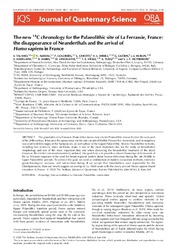The new 14C chronology for the Palaeolithic site of La Ferrassie, France: the disappearance of Neanderthals and the arrival of Homo sapiens in France
Aldeias, V.
Goldberg, P.
Chiotti, L.
Dibble, H. L.
Guérin, G.
Hublin, J.‐J.
Madelaine, S.
Maria, R.
Sandgathe, D.
Steele, T. E.
Turq, A.
Mcpherron, S. J. P.
DOI: https://doi.org/10.1002/jqs.3236
Persistent URL: http://resolver.sub.uni-goettingen.de/purl?gldocs-11858/8486
Persistent URL: http://resolver.sub.uni-goettingen.de/purl?gldocs-11858/8486
Talamo, S.; Aldeias, V.; Goldberg, P.; Chiotti, L.; Dibble, H. L.; Guérin, G.; Hublin, J.‐J.; Madelaine, S.; Maria, R.; Sandgathe, D.; Steele, T. E.; Turq, A.; Mcpherron, S. J. P., 2020: The new 14C chronology for the Palaeolithic site of La Ferrassie, France: the disappearance of Neanderthals and the arrival of Homo sapiens in France. In: Journal of Quaternary Science, Band 35, 7: 961 - 973, DOI: 10.1002/jqs.3236.
 |
Dokument öffnen: |
The grand abri at La Ferrassie (France) has been a key site for Palaeolithic research since the early part of the 20th century. It became the eponymous site for one variant of Middle Palaeolithic stone tools, and its sequence was used to define stages of the Aurignacian, an early phase of the Upper Palaeolithic. Several Neanderthal remains, including two relatively intact skeletons, make it one of the most important sites for the study of Neanderthal morphology and one of the more important data sets when discussing the Neanderthal treatment of the dead. However, the site has remained essentially undated. Our goal here is to provide a robust chronological framework of the La Ferrassie sequence to be used for broad regional models about human behaviour during the late Middle to Upper Palaeolithic periods. To achieve this goal, we used a combination of modern excavation methods, extensive geoarchaeological analyses, and radiocarbon dating. If we accept that Neanderthals were responsible for the Châtelperronian, then our results suggest an overlap of ca. 1600 years with the newly arrived Homo sapiens found elsewhere in France.
Statistik:
ZugriffsstatistikSammlung:
This is an open access article under the terms of the Creative Commons Attribution License, which permits use, distribution and reproduction in any medium, provided the original work is properly cited.

